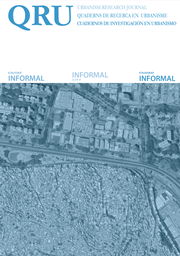FORMA URBANA E SEGREGAÇÃO. Uma análise morfológica dos assentamentos informais do entorno de conjuntos habitacionais em Ananindeua/Pará
DOI:
https://doi.org/10.5821/qru.10390Keywords:
Morfologia, Assentamentos Informais, Consolidação, Forma UrbanaAbstract
Este trabalho se propõe a contribuir com uma análise morfológica dos assentamentos informais situados no entorno dos conjuntos habitacionais Cidade Nova, Guajará e PAAR, localizados no município de Ananindeua, Região Metropolitana de Belém, Estado do Pará. Foram escolhidos quatro assentamentos informais em virtude de suas respectivas localizações, relações de proximidade com os conjuntos habitacionais supracitados, forma espacial, suas conexões e limitações do sítio físico. Neles foram identificadas proporções de dimensões de quadras e lotes, massa edificada, e a relação entre o traçado da malha urbana dos assentamentos informais com as dos conjuntos habitacionais, visando identificar as transformações ocorridas e o nível integração/segregação dos recortes destacados. É demonstrado que a forma urbana dos assentamentos informais periféricos revela um processo de consolidação com padrões espaciais determinados em grande medida pela espacialidade dos conjuntos habitacionais.
Downloads
Published
Issue
Section
License
Those authors who have publications with this journal, accept the following terms:
a. Authors will retain their copyright and guarantee the journal the right of first publication of their work, which will be simultaneously subject to the Creative Commons CC BY-NC-ND-4.0 recognition license that allows third parties to share the work provided that its author and its first publication are indicated in this journal, but they cannot be changed or used commercially.
b. Authors may adopt other non-exclusive license agreements for the distribution of the version of the published work (eg: deposit it in an institutional telematic archive or publish it in a monographic volume) provided that the initial publication in this journal is indicated.
c. Authors are allowed and recommended to disseminate their work through the Internet (e.g. in institutional telematic files or on their website) before and during the submission process, which can lead to interesting exchanges and increase citations. of the published work. (See The effect of open access).













